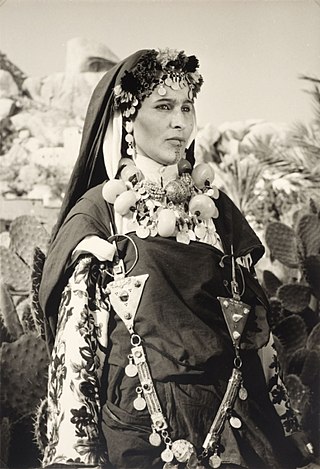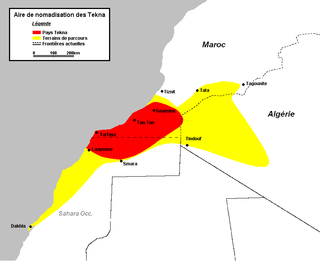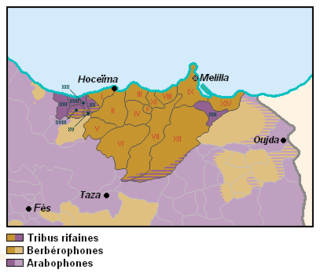Maghrebi Arabic, often known as ad-Dārija to differentiate it from Literary Arabic, is a vernacular Arabic dialect continuum spoken in the Maghreb. It includes the Moroccan, Algerian, Tunisian, Libyan, Hassaniya and Saharan Arabic dialects. Maghrebi Arabic has a predominantly Semitic and Arabic vocabulary, although it contains a significant amount of Berber loanwords, which represent 2–3% of the vocabulary of Libyan Arabic, 8–9% of Algerian and Tunisian Arabic, and 10–15% of Moroccan Arabic. Maghrebi Arabic was formerly spoken in Al-Andalus and Sicily until the 17th and 13th centuries, respectively, in the extinct forms of Andalusi Arabic and Siculo-Arabic. The Maltese language is believed to have its source in a language spoken in Muslim Sicily that ultimately originates from Tunisia, as it contains some typical Maghrebi Arabic areal characteristics.

The Atlas languages are a subgroup of the Northern Berber languages of the Afro-Asiatic language family spoken in the Atlas Mountains of Morocco. By mutual intelligibility, they are a single language spoken by perhaps 14 million people; however, they are distinct sociolinguistically and are considered separate languages by the Royal institute of the Amazigh culture. They are:

Senhaja de Srair is a Northern Berber language. It is spoken by the Sanhaja Berbers inhabiting the central part of the Moroccan Rif. It is spoken in the Ketama area west of the Tarifit speaking area in eastern Rif.

The Ghomara language is a Northern Berber language spoken in Morocco. It is the mother tongue of the Ghomara Berbers, who total around 10,000 people. Ghomara Berber is spoken on the western edge of the Rif, among the Beni Bu Zra and Beni Mansur tribes of the Ghomara confederacy. Despite being listed as endangered, it is still being passed on to children in these areas.

The Shilha people, or Schleuh or Ishelhien, are a Berber subgroup primarily inhabiting the Anti-Atlas, High Atlas, Sous valley, and Soussi coastal regions of Morocco.

The Sanhaja were once one of the largest Berber tribal confederations, along with the Zanata and Masmuda confederations. Many tribes in Algeria, Libya, Mali, Mauritania, Morocco, Niger, Senegal, Tunisia and Western Sahara bore and still carry this ethnonym, especially in its Berber form.

Algerian Arabic, natively known as Dziria, Darja or Derja, is a variety of Arabic spoken in Algeria. It belongs to the Maghrebi Arabic dialect continuum and is mostly intelligible with the Tunisian and Moroccan dialects. Darja (الدارجة) means "everyday/colloquial dialect".

The Tekna is a semi-nomadic Sahrawi tribal confederation of mixed Arab and Lamta Sanhaja Berber origins. Its constituents today inhabit southern Morocco, northern Western Sahara and western Algeria, but traditionally with wider migration routes.

The Jebala are a tribal confederation inhabiting an area in northwest Morocco from the town of Targuist to the west. The Jbala region thus occupies the western part of the Rif mountains. The Jbala has a population of 1,284,000 and is divided into over 42 Arab tribes, today known as "rural communes", and adjacent to them are a small group of 9 Arabized tribes called the Ghomaras (غمارة), who inhabit the territory between the line of mountain peaks to the north of Chefchaouen and the Mediterranean Sea. In addition to tribal heterogeneity, this region is also geographically diverse. High mountains are interspersed with hills and flatlands, and local inhabitants settle in both the high mountains and valleys. In addition to the rainy climate, which influences the way the inhabitants build their houses as well as their special agricultural practices, there are also numerous cultural characteristics that contribute to an emphasised sense of identity and make the Arab Jbala people clearly distinguishable from their Berber neighbours from the eastern part of the Rif Mountains who live between Targuist and Zaio where the climate is more arid. Nowadays, most Jebala no longer identify with a tribe and are also called Chamalis, just like the Arabs of the cities in northwest Morocco,. Most Jebala mainly live in cities such as Tangier, Tetouan, Ksar Kebir, Ksar es Sghir, Larache, Ouazzane, Asilah, Chefchaouen, Taounate.

Central Atlas Tamazight or Atlasic is a Berber language of the Afroasiatic language family spoken by 3.1 million speakers.

Riffians or Rifians are a Berber ethnic group originally from the Rif region of northeastern Morocco. Communities of Riffian immigrants are also found in southern Spain, Netherlands and Belgium as well as elsewhere in Western Europe. They are overwhelmingly Sunni Muslims, but retain their pre-Islamic traditions such as high status for Riffian women.

Arabic, particularly the Moroccan Arabic dialect, is the most widely spoken language in Morocco, but a number of regional and foreign languages are also spoken. The official languages of Morocco are Modern Standard Arabic and Standard Moroccan Berber. Moroccan Arabic is by far the primary spoken vernacular and lingua franca, whereas Berber languages serve as vernaculars for significant portions of the country. The languages of prestige in Morocco are Arabic in its Classical and Modern Standard Forms and sometimes French, the latter of which serves as a second language for approximately 33% of Moroccans. According to a 2000–2002 survey done by Moha Ennaji, author of Multilingualism, Cultural Identity, and Education in Morocco, "there is a general agreement that Standard Arabic, Moroccan Arabic, and Berber are the national languages." Ennaji also concluded "This survey confirms the idea that multilingualism in Morocco is a vivid sociolinguistic phenomenon, which is favored by many people."
Jijeli, or Jijel Arabic, is a variety of Arabic spoken specifically in the Jijel Province in northeastern Algeria, but traces of it reach parts of the neighboring Skikda and Mila Provinces. It is quite different from all the other Arabic dialects spoken in eastern Algeria and has probably survived into present times because of the geographic enclavement of that mountainous area and the difficulty of terrestrial connections with the rest of the country for centuries.
Ait Attab is a large agricultural river valley on the northern edge of Azilal province in Morocco. Its population is divided into a multitude of hamlets called douwars in Darija, the largest one being Al Garage, which is also referred to as Ait Attab Center, or more simply as Ait Attab.
Maghrebi Arabs or North African Arabs are the inhabitants of the Maghreb region of North Africa whose ethnic identity is Arab, whose native language is Arabic and trace their ancestry to the tribes of the Arabian Peninsula. This ethnic identity is a product of the centuries-long Arab migration to the Maghreb since the 7th century, which changed the demographic scope of the Maghreb and was a major factor in the ethnic, linguistic and cultural Arabization of the Maghreb region. The descendants of the original Arab settlers who continue to speak Arabic as a first language currently form the single largest population group in North Africa.
The Hilalian dialects are a continuum of Arabic dialects of the Maghreb, which were introduced during the Hilalian invasions between the 11th and 12th centuries, as well as the migration of Arab Hilalian tribes to the Western Maghreb. These dialects played a great role in the emergence of the Egyptian and Maghrebi dialects. The Bani Hilal tribes settled in the region of Casablanca-Settat in Morocco, parts of Libya, central Algeria, and Tunisia.
Pre-Hilalian dialects also called Early Maghrebi Arabic are a continuum of Arabic dialects native to North Africa. They constitute, along with the Hilalian dialects, the larger Maghrebi Arabic family.

Eastern Middle Atlas Berber is a cluster of Berber dialects spoken in the eastern and north-eastern parts of the Middle Atlas, in Morocco. These dialects are those of the tribes of Ait Seghrouchen, Ait Warayn, Marmoucha, Ait Alaham, Ait Youb and Ait Mourghi.
The Fessi dialect is a dialect of Moroccan vernacular Arabic, or Darija, associated with the city of Fes, especially with the old elite families of the city.

The Arab migrations to the Maghreb involved successive waves of migration and settlement by Arab people in the Maghreb region of North Africa, encompassing modern-day Algeria, Libya, Morocco and Tunisia. The process took place over several centuries, lasting from the early 7th century to the 17th century. The Arab migrants hailed from the Middle East, particularly the Arabian Peninsula, with later groups arriving from the Levant and Iraq.













